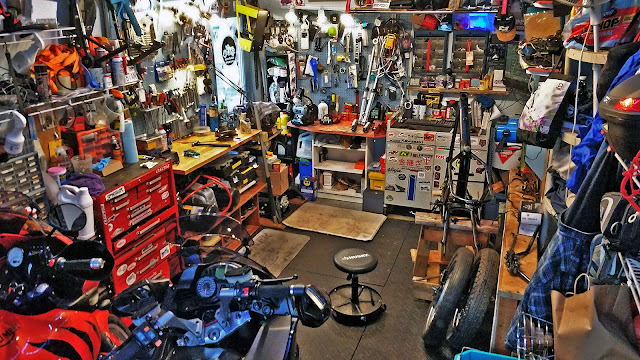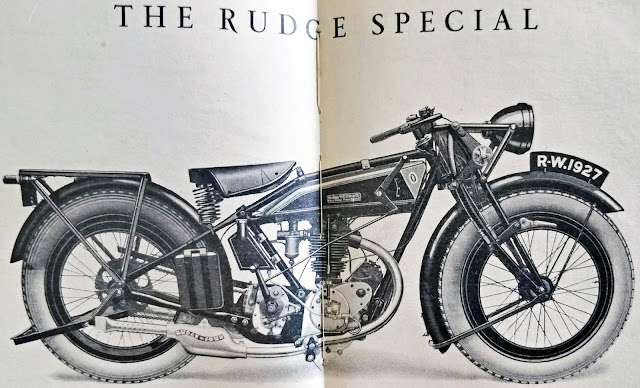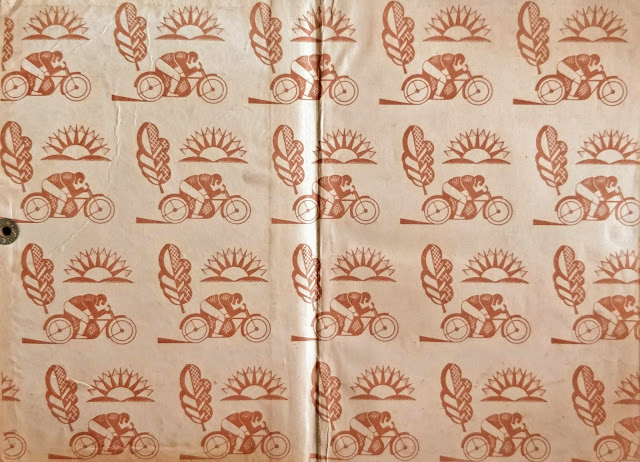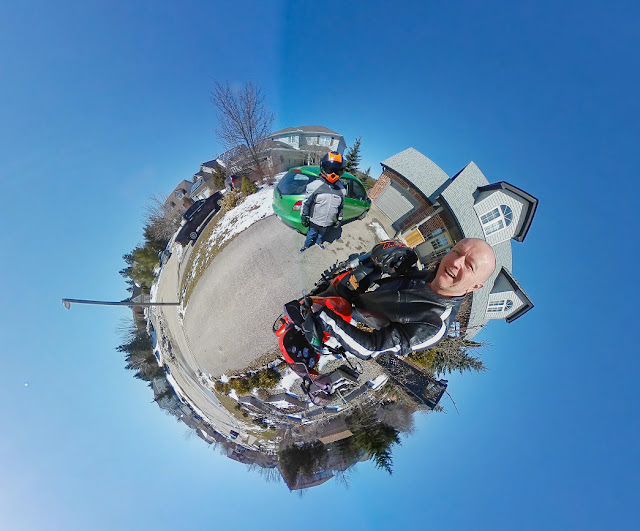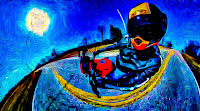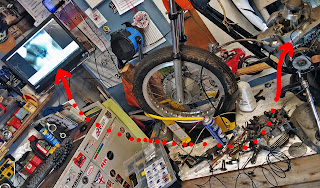Long before I got into riding motorcycles I discovered ice hockey as a new immigrant to Canada. I played whenever I could from backyard rinks to 5am practices to driving miles for games on evenings and weekends. The smell of a hockey rink is a happy one for me, as is the process of getting ready for a game. For many years I played net, which involved putting on over 70lbs of gear each time (this was back in the day when it was made with leather and bricks rather than the fancy space-aged stuff they have now).
My ride starts when I go out into the garage and start putting the kit on. This isn’t tedious, it’s a chance to echo all those hours spent in cold arenas getting ready to lay it all out there on the ice; it’s an opportunity to put on my game face. I never end up on the bike out on the road half paying attention or thinking about something else because putting on the kit is a integral part of getting ready to ride for me.
 |
| I don’t know about a different person, but I am a focused person. Here’s the MotoGP video. |
Back in 2015 we rode down to the Indy MotoGP round. Helmets are optional down that way and we went out once to pick up dinner just up the road without helmets, and it just felt wrong. The right kit means you can ride longer without getting wind or sunburned and can even make you more comfortable than free bagging it. Once you’ve got that approach, trying it the other way just feels wrong.
Helmets are especially important. I’m partial to Roof Helmets because they’re of high quality and are an advanced, modular design that lets you change from a fully safetied full face helmet (lots of flip ups are only safetied as open-face helmets) to an open face ‘jet’ style helmet with a quick flip. They’re aerodynamic, quiet and ventilate well. I’ve tried many different lids, including a dalliance with that beaked adventure nonsense, but (for me) a helmet that lets me feel wind on my face quickly and easily (I can flip it up when passing through a town then be back to full face comfort again in seconds without stopping) was what worked. Getting into kit that feels this right and is well made is all part of the pre-ride ritual and is no hardship.
 I frequently see people out on bikes that are wildly unequipped. They’re usually the cruiser-Captain Jack Sparrow types who are into riding for style rather than, um, riding. The bikes they tend to ride aren’t really into going around corners (or much else) and their riding gear follows suit. If that’s your kind of motorcycling then you’re probably not reading this anyway.
I frequently see people out on bikes that are wildly unequipped. They’re usually the cruiser-Captain Jack Sparrow types who are into riding for style rather than, um, riding. The bikes they tend to ride aren’t really into going around corners (or much else) and their riding gear follows suit. If that’s your kind of motorcycling then you’re probably not reading this anyway.If you watch any motor racing you’ll be aware of pre-race rituals that many riders adopt. Valentino Rossi was famous for his pre-race contortions, and those are only the visible ones! Doing this sort of thing looks eccentric, but you do what works for you in order to get yourself into a peak performance mindset. The amazing things you see athletes do don’t happen without mental preparation. Riding your bike well won’t happen without it either. Don’t get frustrated at putting your gear on, use that time to get yourself into the zone for your ride.
LINKS
Sports Psychology:
https://gladiatorguards.com/the-psychology-of-sports-equipment-how-does-gear-affect-your-team/
https://www.theguardian.com/science/neurophilosophy/2011/oct/24/psychology-neuroscience
https://www.betterup.com/blog/sports-psychology
https://www.billyhansen.net/pregame-meditation
Getting in the Zone:
https://www.inc.com/jessica-stillman/3-tricks-to-help-you-get-in-the-zone.html
https://www.peaksports.com/sports-psychology-blog/mindsets-to-help-athletes-perform-in-the-zone/
https://drstankovich.com/tips-for-athletes-looking-to-get-in-the-zone/
Peak Performance:
https://theathleteblog.com/peak-performance-mindset/
https://www.apa.org/education-career/guide/subfields/performance
Take advantage of pre-game routines:
Athletes stand a much better chance for getting in the zone when they make it a point to engage in a pre-game routine that allows them to think about the upcoming game, elevate their mood state, and lower their negative anxiety.
Moto Specific:
https://www.motogp.com/en/news/2018/01/18/racing-together-superstition/248214
https://www.pinkbike.com/news/racing-pre-race-rituals-traditions-and-rules-2015.html
https://www.worldsbk.com/en/news/2022/Rider+rituals+how+do+WorldSBK+competitors+get+ready+for+a+race
https://www.asphaltandrubber.com/racing/motorcycle-ritual-motogp/
https://www.motosport.com/blog/motocross-superstitions-rituals-10-best
from Blogger https://ift.tt/56IXPz7
via IFTTT





























